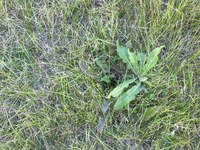Dakota Gardener: Help Your Lawn Recover From Drought
(Click an image below to view a high-resolution image that can be downloaded)
By Tom Kalb, Horticulturist
NDSU Extension
This summer has been very stressful for lawns. The historic drought of 2021 turned many of our lawns brown and crispy.
That’s in the past.
Temperatures have cooled off recently and we finally are getting some rain. This opens an opportunity for us to strengthen our lawns before winter.
Start by fertilizing your lawn. The fertilizer will thicken your turf and strengthen its root system this fall.
Applying a lawn fertilizer with potash in it is especially important this year. This is the third number listed on the bag. For example, a 30-0-10 fertilizer contains 30% nitrogen, 0% phosphate and 10% potash. This potash will help our lawns recover from the stresses of this summer’s drought and the upcoming winter’s cold temperatures.
Let’s aim to apply the fertilizer near Labor Day. Irrigate the lawn after fertilizing.
Many of our lawns are full of weeds now. These weeds kept growing this summer while our lawn grasses turned brown and went dormant.
The key to killing a weed is to get the herbicide down into its roots.
As the nights get longer and the temperatures cool off, weeds will start moving their nutrients down into their roots to prepare for winter.
This movement down into roots makes fall the most effective season to kill hard-to-control perennial weeds such as thistle, field bindweed, clover and dandelion.
When you spray a perennial weed this fall, the plant will move the herbicide naturally down into its roots along with its nutrients.
The first step is to get the herbicide absorbed by the leaves of the weed. That’s why herbicide sprays are more effective than granular (usually weed-and-feed) products. Herbicide granules sometimes drop off weed leaves before they are absorbed.
Let’s aim for weed control operations sometime in mid- to late September.
Spot treatments are best to minimize the exposure of yourself and your landscape plants to toxic chemicals. Read the label of the herbicide carefully and follow its instructions.
If the drought created some bare spots in your lawn, now is a great time to sow seed and repair the damage. Now through mid-September is the best time to sow grass seed. The ground is warm, and the seed will germinate quickly.
Rake out the dead patches, sow the grass seed and lightly rake the seed into the soil.
Keep the soil moist with frequent, light waterings for two to three weeks until the seeds germinate and become established. Try to water at least once every day for a few minutes to keep the seed bed moist and to help the seedlings grow.
Another way to improve your lawn this fall is to aerate it. September is the best month to aerate your lawn.
A core aeration will open air pockets in the soil, encouraging more roots to grow. Remove cores as deeply as possible, taking a few passes over the lawn. Best results are attained when the soil is slightly moist.
You can aerate, sow and fertilize on the same day, if you want.
Thank goodness for the rains we are receiving now. Let’s take advantage of this cooler, wetter weather to help our lawns recover from drought and prepare for winter.
For more information about gardening, contact your local NDSU Extension agent. Find the Extension office for your county at https://www.ag.ndsu.edu/extension/directory/counties.
NDSU Agriculture Communication - Aug. 31, 2021
Source: Tom Kalb, 701-328-9722, tom.kalb@ndsu.edu
Editor: Ellen Crawford, 701-231-5391, ellen.crawford@ndsu.edu




